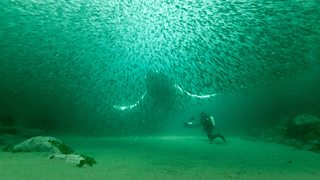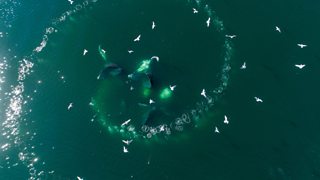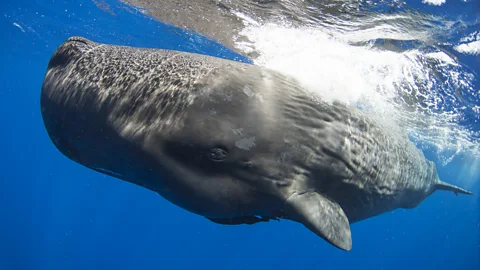In a world-first, scientists had a “conversation” with a whale. Now, researchers are trying to find out what they are actually saying.
A growling “throp” noise emanates from the research vessel’s underwater speaker. A humpback breaks away from its group and approaches. The mammal circles the boat. It surfaces and then dives again, tail slipping noiselessly into the water, and echoes the call back.
Researchers who “conversed” with a humpback whale say their encounter could be the first step towards communication with non-human intelligence. It was in 2021, off the coast of south-east Alaska, that the team of six scientists played a recording of a humpback greeting call using an underwater speaker. They were stunned when one humpback whale they had named Twain responded in a conversational manner.
“It’s like experiencing another world. You hear them come up to the surface. Then there’s this big breath, you can see it, and they’re all together as a group. It’s just incredible,” says Josie Hubbard, an animal behaviourist currently studying for her PhD at the University of California, Davis.
Hubbard was on the research vessel which was floating, all engines silenced, in Frederick Sound, Alaska, when she encountered humpback whales for the first time. “As per regulations, you have to stop a couple of hundred metres away [from the whales] and turn your engine off,” says Hubbard. Rarely, she says, the whales may approach. In this instance, 38-year-old Twain did move towards the boat, and proceeded to circle the vessel for 20 minutes.
Hubbard is part of a Search for Extraterrestrial Intelligence (Seti) research team, hoping to understand the communicative complexity and intelligence of humpback whales. Up on the top deck, Hubbard was oblivious to the work of the acousticians going on beneath the surface. Below deck, Brenda McCowan was broadcasting a recorded humpback contact call – a “whup” or “throp” – through an underwater speaker. When Twain finally moved away, Hubbard ran downstairs to find a hubbub of excitement. Twain had “spoken” back, engaging in a “conversation” that lasted a full 20 minutes.

Long, rhythmic and constantly evolving, whales’ haunting songs can flow across entire ocean basins. They chatter with whistles and pulses, or use echolocation to paint pictures of their underwater world.
Whales have enchanted humans for centuries. In fact, whales display a long list of behaviours similar to humans. They cooperate with one another, as well as other species. They teach each other useful skills, look after each other’s young, and play.
However, unlike humans, the dominant sense in whales is not sight, but hearing. Sink 200m (660ft) below the ocean surface, and you’ll travel beyond the reach of light. Sound, on the other hand, can move farther and faster in water than it does in the air.
Baleen whales, including humpbacks, right whales and blue whales, have evolved a unique larynx that allows them to produce super low-frequency sounds which can travel huge distances. Blue whales, for instance, emit frequencies as low as 12.5 Hz, classed as infrasound and below the threshold of human hearing. Toothed whales, meanwhile, which include sperm whales, dolphins, porpoises and orcas, are the among loudest animals on Earth and use ultra-fast clicks for echolocation, to “see” their world, as well as soft burst pulses and whistles to communicate.
Cetaceans have evolved over 50 million years to produce and hear a variety of complex sounds. They rely on noise to communicate with each other, to navigate, find mates and food, defend their territories and resources, and avoid predators. Their young babble much like human infants, some are believed to have names, and groups from different parts of the ocean have regional dialects. Whales have been heard mimicking the dialects of foreign groups – and some are even thought to have given human language a shot.
The songs of the humpback whale are thought to be among the most complex in the animal kingdom. The first recording of humpback whale song was made in 1952 by US Navy engineer Frank Watlington. Almost 20 years later, marine biologist Roger Payne noticed these calls were organised in repeating patterns. This transformed our understanding of whale vocalisations and sparked an interest that would lead to decades of research.
Responsible whale watching
Whale watching is big business, with over 13 million people worldwide taking a whale watch trip every year. And, while an encounter with a whale can be an incredible experience, it’s important to do it in a way that doesn’t cause them harm. The researchers featured in this article had special permits to carry out their work. Here’s how you can whale watch responsibly.
Fast forward to today, and the Seti research team hopes deciphering whale communication could help us to understand aliens, should we encounter any. The group hypothesises that whale sounds contain complex, intelligent messages akin to languages used by humans or potentially extraterrestrials. However, says McCowan, our understanding of whale communication is still very much in its infancy.
On that particular day off the coast of Alaska, McCowan had already broadcast a host of different sounds, with no response. “But this one call was recorded the day before,” she says, “and it was from this population of whales. After playing the contact call three times, we got this huge response. Then, to keep the animal engaged, I started trying to match the latency of her calls to our calls. So, if she waited 10 seconds, I waited 10 seconds. We ended up matching each other. We did this 36 times over a 20-minute period.”
Throughout the exchange, Twain consistently matched the interval variations between each playback call. This is thought to be the first intentional human-whale interaction in humpback whale “language”. And, as the recording was of Twain’s family group, adds Hubbard, this could indicate some form of recognition, possibly even self-recognition.
However, studying whales is not without its challenges. McCowan emphasises Twain chose to approach the boat and was free to leave whenever she wanted – but therein lies the problem. Whales can usually be found wherever the fish are, adds Hubbard. “But we don’t know where the fish are. So, you have to search to find them in order to study them.” And, to get a complete picture, researchers need to replicate the data with multiple unique pods.
Next, the team plan to vary the calls they broadcast. “We’re still at a very early stage,” says McCowan. “A big challenge for us is classifying those signals and determining their context, so we can ascertain meaning. I think AI will help us do that.”
 Dan Tchernov
Dan TchernovMore than 5,000 miles (8,000km) away, a group of artificial intelligence and natural language processing experts, cryptographers, linguists, marine biologists, robotic experts and underwater acousticians are also hoping to use AI – this time to decipher sperm whale conversation.
Launched in 2020, Ceti (Cetacean Translation Initiative), led by marine biologist David Gruber, has been continuously recording a group of whales off the coast of Dominica, an island in the Caribbean, using microphones on buoys, robotic fish and tags fitted to the whales’ backs.
Gruber is somewhat of an anomaly. He is a microbiologist – a scientist who studies the microscopic – who has gone on to work with some of the largest creatures on the planet. He began his career looking at the interactions of bacteria and protozoa in the ocean in relation to carbon cycling and climate change. From this he moved through coral, jellyfish and sharks until his interests brought him to whales. “It’s really about seeing the world from the perspective of animals,” he says, or in the case of whales, “hearing the world”.
We should probably do more listening, and less talking – Samantha Blakeman
Sperm whales, which have the largest brains of any animal, gather at the ocean’s surface in family groups and communicate using Morse code-like sequences of clicks known as codas. The group of sperm whales that Ceti has been working with is made up of around 400 mothers, grandmothers and calves. This pod , or two evenly spaced clicks and then three clicks in quick succession.
“It’s difficult for us to peer into their world, other than these very brief interactions at the surface. This is such a unique, gentle creature, and there’s just so much going on,” says Gruber. “Each time we look, we find deeper complexity and structure in their communication.” He believes that we are reaching a point of technological advancement that means we could – “possibly” – decode whale communication.
The data collected has been processed using machine-learning algorithms to detect and classify clicks, with results due to be published in 2024. The aim, says Gruber, is to be able to reconstruct “multi-party conversations” – in other words to create a “conversation” using the sperm whales’ own vocalisations.

New technologies have aided hunters before. Take sonar, which can be used to locate and scare whales to the surface where they can be more easily shot. “We should probably do more listening, and less talking,” says Samantha Blakeman, a marine data manager for the National Oceanography Centre. She warns we should be wary of anthropomorphism. “As a scientist, you try to study things without bias,” she says. “You’re always trying to remove yourself from the equation – but it is really difficult to do.”
Baleen whales are at the top of the food chain, notes Blakeman, which means they play a really important role in the ecosystem. “They’re an indicator for those of us studying the health of ocean ecosystems – because anything that happens lower down in the food chain will affect what happens at the top,” Blakeman says. More than a quarter of all cetacean species are under threat, largely because of human activity.
Whales are also natural fertilisers, says Blakeman. A limiting factor for life in the ocean is a lack of iron. Phytoplankton needs light and nutrients to grow. They can usually find nitrates and phosphates – but iron tends to be missing. But whales’ faeces has a high concentration of iron. “They feed in one area and excrete in another,” she says, “putting the iron back into the water, which can cause a flurry of life in this new area”.
 Amanda Cotton
Amanda CottonWhales also play an important role in the Earth’s carbon cycle. Marine plankton captures carbon through photosynthesis. This plankton is then eaten by whales. “When they die [whales] sink to the bottom of the ocean,” says Blakeman. “So, that carbon is kept from the atmosphere for a very, very long time.”
Gruber hopes Ceti’s work will increase humans’ connection to nature. “AI could allow us to understand the communication systems of many other life forms on a much deeper level. I think it would be a good thing for the world if we really listen – if we care deeply about what whales are saying.”


